Basic knowledge of Fine Coffee Culture
I don't know how you are in other parts of Southeast Asia, but I am always at a loss on the streets of Singapore, on the corner of Vietnam and on a sign in Malaysia. Although transliteration of things like "coffee" was used "across the board" by clever ancestors in the early years of its spread, there is not much audio-visual barrier. Even if Singaporeans always call coffee by Kopi, which is pronounced from Hokkienese, it is not a big deal, but I am like the blond Europeans around me who are very confident about coffee. I don't know what happened to Kopi O and Kopi C to be decisively put on the sign of the cafe, which is usually the location of Espresso or Cappuccino at Starbucks.
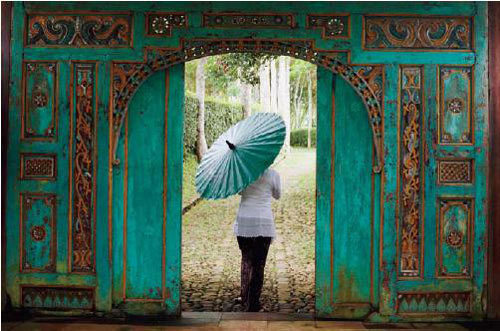
Opening the door to Southeast Asian coffee tours
Of course, I believe I'm luckier than the one next to me, at least through the gray cells of my brain, to understand what happened to the word Kopitiam(Singapore coffee shop), which is basically a transliteration of "coffee shop" in Chinese. In fact, cafes in Southeast Asian countries such as Singapore and Malaysia have deep roots in China, and it is not only because of the large number of Chinese. According to K.F.Seetoh, founder of Makansutra, a famous food guide in Singapore, in the early 20th century, many local cafes opened in Singapore and Malaysia, and most of the people who opened and patronized cafes were "lower Nanyang." Rich businessmen came to the New World with bulging pockets. In order to integrate into the so-called English civilization world, Western civilization was the fashion trend. When they gathered in cafes, they accidentally became a culture.
Of course, there are other benefits to coffee shops, enough to satisfy pragmatic Chinese. At that time, many of these cafes came from Hainan, China, which is also an interesting thing about Singapore. It is said that the Chinese who defected to Singapore in those years always had different batches according to the provinces, while the Hainanese finally arrived, most of the industries had been occupied by people from other provinces, so the Hainanese could only operate the catering industry, among which Hainanese chicken rice would become a local famous dish by chance. Most of these Hainanese who opened cafes also enjoyed the same experience. When they worked on British ships, they often helped in the kitchen. When they returned to the land from the drifting sea, they brought back the British catering culture (which was obviously more popular than Chinese food in Singapore at that time).
In those days, cafes had plenty of seats and served cheap breakfast or lunch along with coffee. Although most traditional Singapore Kopitiam shops have been transformed, such as Yakun or Killiney Kopitiam, there are still exceptions. For example, Chin Mee Chin Confectionery, which opened on East Coast Road in the eastern district, has maintained its original appearance. In Singapore, which is three-quarters summer, it is not even equipped with air conditioning. It shows that the coffee shop in the past is not a luxurious place, but a variant of the tea house. But the menu is mostly Western. A typical breakfast (which will only flatten your purse a little) includes a cup of coffee or tea and a hard-boiled egg, served with a plate and soy sauce. The typical way for locals to eat eggs is to beat them into a plate, then mix them with soy sauce and sprinkle them with pepper, and eat them like pudding.
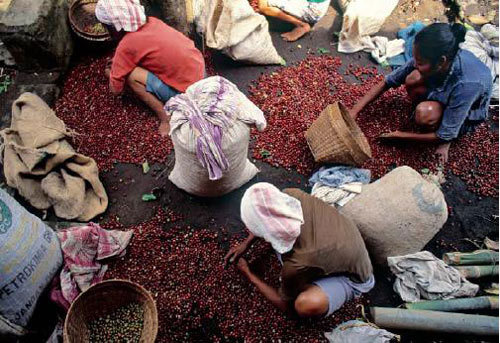
The reason why the imported product of coffee can enter Southeast Asia is due to Western colonialism.
Another indispensable part is the so-called Kaya Toast, which should be called coconut toast. Butter and homemade Kaya sauce are not put on one side for you to take, but are thickly smeared (or only Kaya sauce) in advance. Kaya sauce is a classic local creation, and this sweet and greasy coconut sauce definitely reflects the common interests of the people of all ethnic groups in Asia. The reason that Zhenmeizhen is still popular until now is that the half-cooked eggs are always just right and the Kaya sauce is always the most authentic. Kopi O or Kopi C mentioned earlier can actually be regarded as "slang".
The coffee here is never served properly with milk and sugar. They are usually made with more processing, such as stir-frying with corn kernels (some say sugar) and butter, which makes the coffee slightly sweet, says Seetoh. "in the old days, they were fried in lard, but now they don't." In cafes, baristas put processed coffee powder into long, thick "socks", a fabric coffee filter that over time infiltrates the taste of coffee (like a purple sand pot). Seetoh stressed that although those "socks" have to be washed thoroughly at the end of the day, they may not be clean.
Then, they will use hot water over the "socks" coffee beans, directly into the condensed milk or milk and sugar cup, there is another cup of "fragrant and strong" coffee. Kopi C refers to coffee with only milk, while C actually comes from Carnation (carnation), a canned milk brand chosen by most Singapore cafes. Although many cafes no longer use this brand, this "slang" continues to be popular. Kopi O means black coffee (with sugar). It is said that it means "black" in Minnan dialect, Kopi Siutai means less sugar, and Kopi Kosong means coffee without sugar or milk, because kosong means "nothing" in Malay. And if you just say kopi, then condensed milk and sugar are added, because that's how they add it all the time, and everything else is based on it.
The most interesting thing is Kopi Tarik, which refers to the kind of coffee that is poured back and forth in two cups before serving, and Tarik means "rewind". The initial effect was to cool down. Singapore is too hot for hot drinks, but this method usually creates a lot of foam in coffee, just like cappuccino, so they invented a new product, called Kopiccino, which is a genius idea. It is not easy to master these "slang", but we can try to learn. For example, if I want a cup of Iced Milk Tea with less sugar, then say, Teh C PengSiutai (really concise), Teh means tea, and Peng means ice in Minnan dialect. How, not difficult, that is, some word problems, has not yet risen to the level of grammar. But it can be pointed out that the reason why Southeast Asian cafes like to use condensed milk instead of milk may be because robusta coffee, which is now more produced in Africa, is better at resisting diseases and insect pests than Arabica coffee with a long history, but the taste will be more bitter, and it is reasonable that heavy flavors need to be re-adjusted.
Indonesian coffee: ill-fated
Indonesia has always been one of the best coffee producers in the world. Java coffee used to be synonymous with top coffee, while Sumatra and Sulawesi are also rich in top coffee. Coffee arrived in Indonesia early and was brought in by the Dutch in the 17th century, when Ceylon, now Sri Lanka, began to grow coffee because of the Dutch. At that time, Arabica coffee was grown in both Indonesia and Sri Lanka.
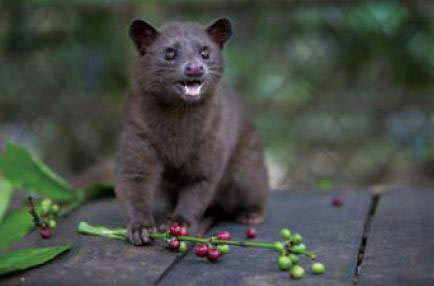
Musk cat, Bali, Indonesia
At that time, Europeans fought for Indonesian coffee, especially Java coffee, which tasted less bitter. Coffee with low acidity is described as: "good Java coffee has this property, it shows a relatively thick, slightly lighter and less acidic than some other Indonesian coffee." This coffee shows a rustic style and a long aftertaste on the whole, with a slight flicker of vegetation in the aftertaste. Compared with other Indonesian coffees, the finish is not that long, but it often contains a slightly spicy and smoky blend. Java coffee gives people an impression of sweetness as a whole, very soft and rich. " I don't know what Java coffee was like in its heyday, but I was excited when I read it.
At that time, this kind of miraculous coffee was only for Europe, and it had to be transported by sailing for a long time, which made the coffee less acidic and tastier. In the more developed period of shipping, merchants had to store the coffee for several years to get a better taste. Storage also brings higher prices, inferior quality, and all kinds of smuggling are common. By the 1880s, Java coffee reached its peak, but the delicate Arabica coffee plant could not escape the plague. a rust hit many areas of Java, including Java, and large tracts of coffee trees died. at that time, only 1/10 Arabica coffee survived in Indonesia, mostly in Sumatra. Then the Dutch again brought Africa's stronger Robusta coffee, which is more resistant to diseases and insect pests, but tasted less than Arabica coffee, and the halo finally left Java.
The old plantations preserved today are now clustered in eastern Java, including Djampit, Blawan, Pancoer, and Kayumas4 plantations, all near the Ijen volcano on the Ijen plateau, who have grown the same kind of coffee from the 18th century to the present. But Java is no longer that Java, and when it comes to Indonesian coffee, people talk more about Sumatran mantenin coffee, or the more magical coffee Kopi Luwak, the legendary civet coffee. Luwak coffee is known as the most expensive coffee in the world, mainly produced in Indonesia's Sumatra, Java and other islands, but it is so rare that the civets swallow the coffee fruit and unexpectedly eliminate most of the bitterness after a "hundred twists and turns". Leave the more delicious coffee.
The coffee was discovered because stingy Dutch planters banned local workers from drinking coffee. In order to get the magical fruit they had worked so hard to grow, they had to find another way to find it in the excrement of civets. After cleaning and grinding, it was made into world-class coffee, which was then found by the Dutch and became more expensive. Bali, as Indonesia's main tourist destination, is often famous for its golden coffee in tourist brochures. In fact, this is the special item of Golden Mandheling coffee in Sumatra, Indonesia, also known as Golden Manning. In Sumatra, which probably escaped the disease in the past, Mantenin is one of the top coffees in the world. It is slippery and mellow, with a heavier taste and a longer aftertaste than Java coffee. It may not be as delicate as Java, but more ferocious. The trademark of the golden butterfly can be identified at the time of purchase.
There are also some plantations in Bali that have been turned into resorts, such as the Munduk Moding plantation, which has been turned into a luxury resort with spa. The resort is close to the Central Lake District of Bali and the Munduk Mountain Station, and the nearby hills are covered with forests, coffee trees and rice, with charming surroundings and rooms with local characteristics. In fact, the greatest charm of Bali compared with other islands lies in its unique culture. Living in the mountains and enjoying Indonesian coffee culture is also a good choice.
Vietnamese Coffee: ambitious
Vietnam's next goal is clearly not just to become the world's second-largest coffee exporter, because it has so many coffee-loving citizens. In Vietnam, drinking coffee between friends is as natural as shaking hands. An Australian food guide who has been in Hanoi for seven years is deeply impressed. A cafe in three or five steps is not only a street view of large and small cities in Vietnam, but also a ritual. In Vietnam, you only share coffee with friends. "it's an important way to socialize, while at home, only drink tea." Obviously, Vietnam, which has been colonized by France for many years, is not only deeply affected by the language. Coffee comes to Vietnam with the French, and coffee is drunk in the same way, often served with baguette and milk sugar.
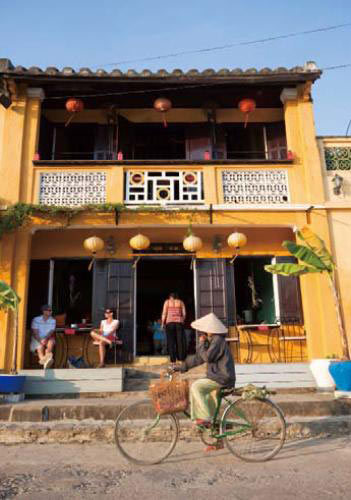
After the reform and opening up, Vietnamese cafes began to receive Western tourists.
Vietnamese coffee is not brewed in a coffee pot, but in a special dripping coffee cup, which is filled with an old-fashioned printed glass and filled drop by drop. It takes a lot of effort in advance to put a drip cup on the mouth of the glass, put coffee powder in the drip, press a piece of metal with holes, and then brew it with hot water to let the coffee tick into the glass below. Some people put a layer of extremely sweet condensed milk in the glass, such as Singaporeans, and then slowly wait for the coffee to drip into the cup, which takes about 10-20 minutes, and finally the black coffee is mixed with white condensed milk to make the mouth bitter and sweet. This complete set of coffee filter is called Ca Phe Phin, do you have some understanding from the pronunciation? In fact, they also have their own coffee slang, which is similar to Singapore's in structure.
Most of the coffee produced in Vietnam is Robusta coffee, mainly and initially produced in the Annan plateau, but the changeable natural environment provides a variety of choices. today, the plateau of northern Vietnam begins to produce Arabica coffee, while the south produces more robusta coffee. In order to narrow the gap with Brazilian coffee in quantity and make a breakthrough in quality, the Vietnamese now put more emphasis on expanding the planting scope of Arabica coffee and have begun to introduce and experiment with some special coffee, such as Indonesian civet coffee, which is locally called C à Ph ê Ch.
The reason for the unique taste of Vietnamese coffee is said to be the addition of butter (occasionally vegetable oil) in the baking process and the use of deep baking in French baking, which is definitely a heavy taste, so it is no wonder that Vietnamese like to drink it by filtering. and drink with sweet condensed milk, otherwise, it is fierce straight to the forehead, fierce aftereffect, and even some people drink straight chest tightness. This sweet taste with bitter ice and fire is also the flavor of Vietnamese coffee. In this place where there are many cafes, it is fun to find the right restaurant and go into one at random.
Malaysian Coffee: unique
Malaysia is closer to Singapore and has more in common in cafe culture and coffee drinking, but the biggest reason coffee gluttons cannot ignore is that Malaysia is the only Liberica coffee producer in the world outside West Africa. This unique coffee has a rich aroma and a light taste, accounting for less than 2% of the coffee grown in the world today, largely because the taste of this coffee is so special that it is not acceptable to everyone, so the market is naturally weaker than Arabica or Robusta. For a long time, Malaysians have gradually abandoned the cultivation of this coffee, or changed to other varieties, of course, more people have chosen oil palm. And Liberica coffee is becoming more and more weak, even in Malaysia, it is only enough for self-sale, it is estimated that it is also like the Maldives, if you do not try, it will eventually be out of this unique taste.
But searching for roots is a nostalgic dream that sweeps the world. On the one hand, the new Kopitiam is booming. Like Singapore, most of the old cafes have been modified, equipped with air conditioning and sofas. This is not a destruction of the tradition, but the best way to maintain the tradition. Old Town is the most famous new and old-fashioned coffee chain in Malaysia, and its popularity has made Ipoh White Coffee the representative of Malaysian coffee. On the other hand, you can also see cafes like Typica in Kuala Lumpur where they roast less and less Liberica coffee by hand, bringing the coffee back to its origin, and sometimes even paying three times the price for coffee beans, so that growers can keep the Liberika coffee. The traditional Liberica coffee will add sugar to the roasting process to make it darker and neutralize the Liberika coffee with an "extensive" flavor that requires no sugar or just a little sugar.
The so-called white coffee, in the roasting process does not add sugar, only butter, so the color is relatively light, but mostly not from Liberia, but from Indonesia. "Bai" has a clean and pure meaning in Chinese, so it complements each other. White coffee does not have a long history compared with local coffee. It first came from Ipoh. Now the fourth largest city in Malaysia is mostly Chinese, Cantonese is the lingua franca. In the early years, it was famous for tin mines, and most of the French moved in. The first Chinese to come here are tin miners (like Phuket in Thailand) and have their own coffee culture. The so-called Old Town is generally known as the old street farm of Ipo. there are also several of the oldest Kopitiam, Xinyuanlong, Xinyuanfeng and Nanxiang, which can eat orthodox white coffee, which is not much different from the traditional Kopitiam, and you can also try Ipoh's famous river noodles.
Laos coffee: fragrance in boudoir
You may not believe it, but Laos does produce the best coffee in the world. Compared with some other parts of Southeast Asia, Laos did not grow coffee for a long time, and it was not introduced by the French until the early 20th century. But the unique natural environment of Laos reveals the king atmosphere of the best coffee in Southeast Asia. Laos coffee is famous for its delicate and complex aroma and rich taste, with citrus fruit and floral aromas and faint chocolate sweetness in the aftertaste. Compared with the coffee with multiple flavors in Southeast Asia, the taste is fresher and milder and longer.
Laos coffee is grown in the Bolaven plateau in the southern province of Bassai, and is basically distributed around Paksong, so Basong is also known as the coffee capital of Laos. The latitude is about 15 degrees, the altitude is more than 1300 meters, the climate is suitable, the rainfall is abundant, and the rich nutrition of volcanic ash geology creates unique conditions for local coffee. In Laos, Arabica and Robusta coffee are grown. Originally all coffee grown in Laos was Arabica, and then because of the disease, about 80% of it was converted to Robusta, and now, like Vietnam, Arabica coffee is being replanted.
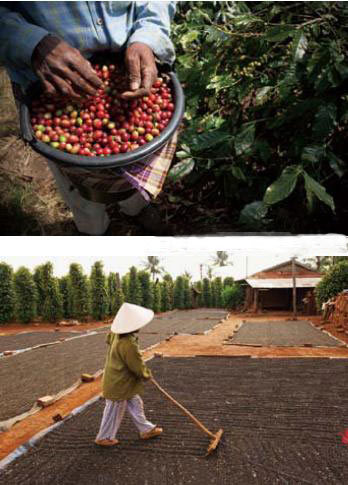
The Golden Triangle drug base has been transformed into coffee plantations and tea plantations.
The production of coffee in Laos is already small, and Arabica sells almost all its own coffee to France, a relationship that has not changed since colonial times. Obviously, after the French left, the Laotians didn't know how to sell coffee. Robusta coffee is exported, sold to Thailand, went to Nestle, maybe this is why Thai Nestle coffee tastes so good. Basong does not have many large plantations, most small farmers produce, although there is the best coffee, but the tourism industry is still in its infancy, if you are a coffee enthusiast, you can also visit the local village. November to January is the harvest time for Arabica coffee, while February to March is Robsta's. If it's not that crazy, go to Vientiane or Luang Prabang cafes and carefully choose first-class local coffee. Remember to choose Arabica coffee varieties. Laotians also like to pour coffee into a glass mixed with condensed milk, and then have another cup of green tea.
Thai Coffee: reborn in the Fire
The Chiang Mai and Chiang Rai provinces in northern Thailand, which have a similar microclimate to the Brofen Plateau in Laos, introduced coffee later than Laos, not because of the personal preference of colonists in an European country, but because poppies are no longer grown here. As the former Golden Triangle town, northern Thailand has always been one of the bases of Kunsha, where the mountains are covered with poppies, and the mountain people here only know how to grow poppies. In fact, soils suitable for growing opium poppies are always suitable for growing high-quality coffee or tea. After drugs were swept out of Thailand in the 1980s, the mountains around Chiang Rai are now tea gardens or coffee plantations. This is a renovation project from the Thai royal family, and the so-called Lanna Cafe Coffee, this brand has been planted by NGO to help local farmers since 1997. there are many NGO projects, environmental protection projects and royal projects that tourists can participate in and contribute to their work, all of which are aimed at finding a new way out for local farmers after wiping out the drug trade. In addition to coffee, local alpine tea production is also looking for more industrial support. Like Lao coffee, they have a complex aroma and delicate taste, and they have become more and more popular in recent years, and their future may even be brighter than Lao coffee.
Important Notice :
前街咖啡 FrontStreet Coffee has moved to new addredd:
FrontStreet Coffee Address: 315,Donghua East Road,GuangZhou
Tel:020 38364473
- Prev
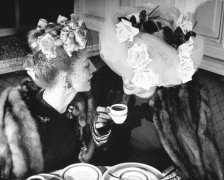
The basic knowledge of Coffee Culture Ulysses Coffee
Core hint: corresponding to the hundred wine fighting poems in the East, coffee has also been endowed with the status of legendary potion in western literature. Today, Espresso and its derivatives are synonymous with literary coffee, and the birth of Espresso is closely related to the eastern Italian city of Trieste. Although the celebrity list of the cafes here is not as dazzling as that of Rome and Paris, it is also
- Next
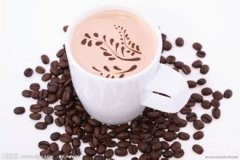
American coffee culture is laissez-faire with no taboos
When Americans drink coffee, it is like playing a game without rules, laissez-faire without taboos. Americans are dismissive of all kinds of exquisite coffee made by Europeans. Americans drink coffee freely, coffee set culture is also deep into their lives difficult to separate, the impact is even to the point that no coffee is not life. It is said that for the first time a man was put on the moon
Related
- How did the Salvadoran coffee industry develop in Central America?
- What exactly does the golden cup extraction of coffee mean?
- The Origin of Coffee flower
- [2023 Starbucks World Earth Day] there are more meaningful things besides free Starbucks coffee!
- What kind of coffee is there in Spain? 9 Flavors of Spanish Coffee
- Aromatic African coffee| Kenya's coffee culture and historical production area
- Liberica Coffee Bean knowledge: the characteristics of Liberian Coffee beans of the three original species of Coffee beans
- The origin and formula of Spanish latte introduces the taste characteristics of Bombon coffee in Valencia, Spain.
- How to adjust the solution of over-extracted coffee
- What is the tasting period of coffee beans? What is the period of coffee and beans? How should coffee wake up and raise beans?

